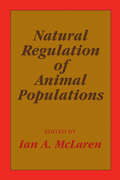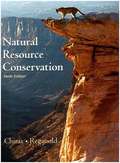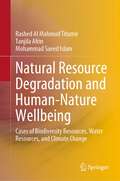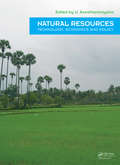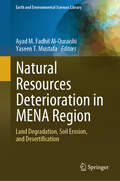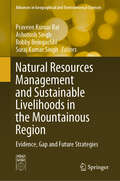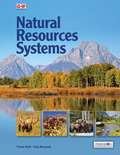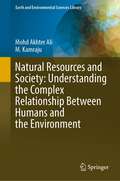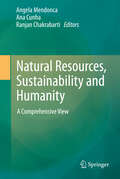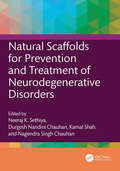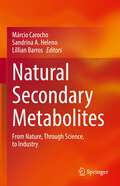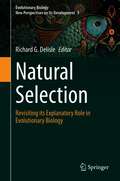- Table View
- List View
Natural Regulation of Animal Populations
by Ian A. McLarenSurveying an area dense with conflicting observations and ideas, this volume vividly depicts the current state of knowledge as well as the great diversity of opinion in the field of population ecology. Ten papers by outstanding authorities focus on three main issues-the effects of environment and population density on population dynamics, the influence of animal behavior on population growth, and the possibilities of genetic feedback or short-term evolutionary change on control of animal populations. An incisive introduction by the editor establishes a frame of reference and supplies succinct resolutions of some of the important controversies dealt with in these pages.
Natural Remedies: Their Origins and Uses
by Desmond Corrigan Finn SandbergThe past two decades have witnessed a phenomenal explosion of interest in the potential uses of plant medicines in healthcare and this has evoked the rebirth of pharmacognosy. This volume is unique in that it is the first, in English, to employ the Anatomical, Therapeutic and Chemical (ATC) classification system, developed by the World Health Organ
Natural Resource Conservation: Management For A Sustainable Future
by Daniel D. Chiras John P. ReganoldThis comprehensive text provides the ecological principles, policies, and practices to manage a sustainable future. It emphasizes practical, cost-effective, sustainable solutions to these problems that make sense from social, economic, and environmental perspectives.
Natural Resource Degradation and Human-Nature Wellbeing: Cases of Biodiversity Resources, Water Resources, and Climate Change
by Rashed Al Titumir Tanjila Afrin Mohammad Saeed IslamThe book addresses the gaps in the body of knowledge from two grounds. Firstly, it adds value through explaining the dynamics of natural resource governance by focusing on the particular arenas of biodiversity resources, water resources and climate change in developing country context. Secondly, it critically scrutinizes the market-centric perspectives on one hand and combines political economy questions that are generally overlooked in discussions of current resource governance framework, on the other. It develops a new framework to examine the reasons behind the degradations of natural resources to offer sustainable solutions to the problems. It shows that the natural resources have been exploited beyond sustainable limits due to the structural rigidities, embedded in, and reproduced by, fragile institutions and unequal power-sharing arrangements under the market-centric economic system. The book formulates a new understanding of sustainability in case of usage and management of natural resources by incorporating the idea of human sociality. It highlights the importance of the well-being of nature, and human beings must go side by side; one without the other is not a sustainable option. The book contains key learnings for scholars and researchers working in the field of development studies who wish to gain a deeper understanding on the sustainable natural resource governance specifically in the contexts of developing countries. For policymakers and policy advocates, the book serves as the groundwork on policies regarding biodiversity resources, water resources, and climate change, specific to the context of developing countries, providing more relevant contents in terms of laying out justification for policy objectives.
Natural Resource Management in the Thar Desert Region of Rajasthan
by Nisha Varghese Sukhdeo Singh Burark K. A. VargheseThis book covers a wide range of issues related to the Thar Desert Region of Rajasthan from an integrated and sustainable development perspective. The chapters in this book cover regional and local issues which are discussed with reference to the past scenario, the present practices, and the future strategies. Some of the issues addressed in this book like arid agroforestry, livelihood, and multidimensional development give it a cutting edge over other related publications currently available in the market. The chapters are supported with relevant pictures which will help the reader to connect with the issues being discussed. This book is useful to students, civil services aspirants, researchers, environmentalists, geographers, and non-professionals who are interested in deserts and desert development.
Natural Resources - Technology, Economics & Policy
by U. AswathanarayanaNatural resources management has two principal dimensions : Science-illuminated (earth, space, hydrological, pedological, information, etc. sciences) management of local resources (waters, soils, bioresources, minerals, rocks, sediments, etc.) in an ecologically-sustainable manner, and Value-addition through processing of natural products, through
Natural Resources Deterioration in MENA Region: Land Degradation, Soil Erosion, and Desertification (Earth and Environmental Sciences Library)
by Yaseen T. Mustafa Ayad M. Fadhil Al-QuraishiLand deterioration, drought, desertification, and water resources shrinkage threaten natural resources, negatively impacting environmental, economic, and political stability. The increasing occurrence of climate change (extremes) impacts land degradation processes, soil erosion by water and wind, and salinization. The researchers have invested several years of scientific research in natural resources deterioration, including soil degradation and erosion, land degradation, desertification, and climate changes, which are interesting enough. However, the link between science and policymaking appears to be less active as serious actions do not take fast. The eighteen chapters of this book focus more on topics related to natural resources deterioration, such as land degradation, desertification, drought, climate change, and analysis of numerous case studies. This book presents experts' overviews, study results, experiences, and knowledge of natural resources deterioration in MENA countries. It attracts researchers, experts, scholars, scientists, academics, students, practitioners, graduates, or anybody interested in land degradation, desertification, climate change, and natural hazards that fall within natural resources deterioration. Therefore, researchers keep continuing to do their investigations and produce results that convince stakeholders and policymaking to act immediately towards protecting natural resources and their sustainability.
Natural Resources Management and Sustainable Livelihoods in the Mountainous Region: Evidence, Gap and Future Strategies (Advances in Geographical and Environmental Sciences)
by Praveen Kumar Rai Ashutosh Singh Suraj Kumar Singh Bobby BeingachhiThis book explores the relationships between natural resources management, sustainable livelihoods, and integrated watershed management in the context of the mountainous region, especially in the northeastern region of India. The book also sheds light on the current state of regional issues, identifies gaps in the existing practices and proposes future policies for effective conservation and sustainable development.The environmental degradation in the northeastern region of India is basically attributed to the increasing biotic pressure on the fragile ecosystems in the absence of suitable investments and proper management practices to enhance and conserve the natural resources. Population growth and poverty on the one hand and the pressure of rising demand from wealth and consumerism on the other hand, have been exerting powerful pressure on the ecosystems. Natural resources planning and management and sustainable livelihoods through integrated watershed management is not just a technical challenge; it is also a social challenge. The book is a valuable resource for policymakers, researchers, practitioners and stakeholders involved in natural resource management, sustainable development and watershed management in the Himalayan region.
Natural Resources Systems
by Travis D. Park Tara L. BerescikNatural Resources Systems is a comprehensive text that features up-to-date coverage of today's natural resources management, including a focus on sustainability, global environmental issues, and the science behind the solutions to natural resources issues. It provides students with a basic introduction to many areas included in natural resources studies, including soil, air, water, endangered species, fisheries, game management, and cartography. Diverse conservation and natural resources management careers are highlighted in the Career Connection features throughout the text to provide students with examples of career paths taken by some of today's successful professionals. Special attention is given to the art of program, which includes pictures, charts, graphs, and illustrations, to education readers and help those who struggle with comprehension. Abundant STEM Connections, Environmental Features, and instructional features throughout the text help students learn by doing.
Natural Resources and Society: Understanding the Complex Relationship Between Humans and the Environment (Earth and Environmental Sciences Library)
by Mohd Akhter Ali M. Kamraju"Natural Resources and Society: Understanding the Complex Relationship Between Humans and the Environment" is a study of the dynamic interplay between humans and the natural world. The book explores the complex relationship between human societies and the environment, examining how human actions can both impact and be influenced by natural resources.The book covers a broad range of topics, including the history of human resource use, the role of natural resources in economic development, and the environmental impacts of resource extraction and consumption. It also considers the social and cultural factors that shape human interactions with the natural world, and the challenges of sustainable resource management. Overall, the book provides a comprehensive overview of the relationship between humans and the environment, emphasizing the importance of understanding this relationship in order to develop more sustainable and equitable societies.
Natural Resources in European History: A Conference Report (Routledge Revivals)
by Antoni Mączak and William N. ParkerNatural Resources in European History pulls together several papers from the Bellagio Conference on Natural Resources and Economic Development which took place in 1977. Originally published in 1978, this report focuses on papers exploring the history of natural resources in Continental Europe presenting research on how resources were traded, collected and depleted between the fifteenth and nineteenth century. This title will be of interest to students of Environmental Studies or with an interest in Environmental History.
Natural Resources, Sustainability and Humanity: A Comprehensive View
by Ana Cunha Angela Mendonca Ranjan ChakrabartiShortly, this book is the written up-graded version of the topics discussed during the Small Meeting of the 2nd International School Congress: Natural Resources, Sustainability and Humanity, held in Braga, Portugal, 5-8 May 2010 with the diverse participation of scientists, educators and governmental representatives. The Earth hosts an immense ecosystem, colonized by millions of species for billions of years but only for a few tens of thousands of years by humans. Environmental history tells though that it was humankind that shaped the environment as no other species. History, geography, religion and politics among other reasons have differentiated populations with respect to access to safe food and water, education, health, and to space and natural resource utilization. The globalization era of trade, information and communication is shortening distances and increasing overall wealth, but, as is pointed out in this book, it is also contributing to the propagation of diseases, and to the modification or even destruction of native ecosystems by exotic invasive species. Man is the only species that has the perception of its history, evolution, of the consequences of its decisions, and that there is a future ahead. It is also the only species that has the potential to change it. This awareness can be a source of anxiety and contradictory behaviours, but it is also the key to changing attitudes towards the construction of a common sustainable home, by committed education, interdisciplinary approaches, mobilization and empowerment of people and political consonant actions.
Natural Satellites: The Book of Moons
by Ron MillerFor centuries, astronomers have placed a special importance on the other planets of the solar system. But with the advent of spacecraft and the tremendous missions undertaken by the Voyager and Cassini probes, astronomers have discovered that the natural satellites of the planets—the solar system's moons—are some of the most extraordinary places imaginable. There are moons with towering geysers, erupting volcanoes, and subterranean oceans of warm, mineral-rich water. Some of the highest mountains and deepest canyons can be found on moons. There are moons that have shattered into pieces and then reassembled. There is even a moon where it rains rocket fuel. Recently, scientists have turned to moons for answers in their investigations of the origins of the solar system and the evolution of life on our own planet. Featuring full-color, scientifically accurate illustrations by NASA artist Ron Miller, Natural Satellites: The Book of Moons chronicles these investigations and the questions we have yet to answer in our exploration of the solar system's moons.
Natural Scaffolds for Prevention and Treatment of Neurodegenerative Disorders
by Durgesh Nandini Chauhan Nagendra Singh Chauhan Kamal Shah Neeraj K. SethiyaNeurodegenerative diseases affect millions of people worldwide and are a group of several diseases with distinct pathology, physiology, prevention, and treatment strategies. Recently, natural products especially derived from medicinal plants are gaining momentum to manage neurodegenerative disease safely and effectively. Therefore, there is an urgent need to provide a ready roadmap for scientifically validated value-added nutraceutical and pharmaceutical safe and effective product for the management of various neurodegenerative diseasesNatural Scaffolds for Prevention and Treatment of Neurodegenerative Disorders will provide compiled information stating several identified neurodegenerative diseases including pathology and physiology. From vast literature on natural products, such asscientifically validated plant bioactives, traditional approaches to combat or prevent neurodegenerative conditions are also included along with molecular mechanisms. The book will further specify: Single window complied information on various neurodegenerative diseases. Possible projection of bioactivity from natural resources to each category of neurodegenerative diseases. Ready-to-use reference material to develop several value-added products or proceed to the next level. The book will be very useful for nutraceutical research groups, education institutions, and industries focusing on developing value-added solutions for the management of several neurodegenerative diseases.
Natural Science
by Immanuel Kant Eric WatkinsThough Kant is best known for his strictly philosophical works in the 1780s, many of his early publications in particular were devoted to what we would call 'natural science'. Kant's Universal Natural History and Theory of the Heavens (1755) made a significant advance in cosmology, and he was also instrumental in establishing the newly emerging discipline of physical geography, lecturing on it for almost his entire career. In this volume Eric Watkins brings together new English translations of Kant's first publication, Thoughts on the True Estimation of Living Forces (1746-1749), the entirety of Physical Geography (1802), a series of shorter essays, along with many of Kant's most important publications in natural science. The volume is rich in material for the student and the scholar, with extensive linguistic and explanatory notes, editorial introductions and a glossary of key terms.
Natural Science and Indigenous Knowledge: The Americas Experience
by Edward A. Johnson Susan M. ArlidgeHow do we combine the areas of intersection between science and indigenous knowledge, but without losing the totality of both? This book's objective is to consider how Indigenous populations have lived and managed the landscape. Specifically, how their footprint was a result of the combination of their empirical knowledge and their culture. The chapters are divided into four groups: The first deals with reintegrating cultures and natural landscapes and the role of kinship and oral tradition. The second group approaches the landscape as a living university of learning and managing, discussing the ethnobotany of how to grow more responsibly, and assess and project the harvest. The third group deals with the managing of fire in an anthropogenic plant community and how to integrate indigenous agriculture in hydrology and dry regions. The fourth group consists of studies of how science and indigenous knowledge can be taught in schools using land-based studies.
Natural Secondary Metabolites: From Nature, Through Science, to Industry
by Lillian Barros Márcio Carocho Sandrina A. HelenoThis book focuses on the different compounds (polyphenols, sterols, alkaloids terpenes) that arise from the secondary metabolism of plants and fungi and their importance for research and industry. These compounds have been the backbone and inspiration of various industries like the food, pharmaceutical and others to produce synthetic counterparts. Furthermore, many of these compounds are still widely used to carry out specific functions in all these industries. This book offers a compilation of different texts from world leading scientists in the areas of chemistry, biochemistry, plant science, biotechnology which compile information on each group of secondary metabolism compounds, and their most important applications in the food, pharmaceutical, cosmetic and textile industry. By showcasing the best uses of these compounds, the chemistry behind their production in plants and fungi, this book is a valuable resource and a "go to" artifact for various audiences. The new approach this book offers, by linking research and the application of these compounds, makes it interesting as an inspiration for new research or as a hallmark of what has been done in the secondary metabolism of plants and fungi in recent years. Although this book may be technical, it is also enjoyable as an integral reading experience due to a structured and integrated flow, from the origins of secondary metabolism in organisms, to the discovery of their effects, their high intensity research in recent years and translation into various industries. Beyond learning more on their chemistry, synthesis, metabolic pathway, readers will understand their importance to different research and industry.
Natural Security: A Darwinian Approach to a Dangerous World
by Raphael D. Sagarin Terence TaylorThe post 9/11 world has so far failed to exploit the insights of the greatest experiment in security of all time--the millions of successful defensive and offensive security strategies that abound in nature. Arms races among invertebrates, intelligence gathering by the immune system, alarm calls by marmots are but a few of nature's security strategies that have been tested and modified over billions of years. This provocative book applies lessons from nature to our own toughest security problems-from global terrorism to the rise of infectious disease to natural disasters. Written by a truly multi-disciplinary group including paleobiologists, anthropologists, psychologists, ecologists, and national security experts, it considers how models and ideas from evolutionary biology can improve national security strategies ranging from risk assessment, security analysis, and public policy to long-term strategic goals. Written with the aim of breaking down barriers between disparate disciplines in order to create more responsive and effective strategies,Natural Security provides a new lens through which to explore the ancient and ever present problem of how to maintain security in an unpredictable, complex, and dangerous world.
Natural Selection: Revisiting its Explanatory Role in Evolutionary Biology (Evolutionary Biology – New Perspectives on Its Development #3)
by Richard G. DelisleThis book contests the general view that natural selection constitutes the explanatory core of evolutionary biology. It invites the reader to consider an alternative view which favors a more complete and multidimensional interpretation. It is common to present the 1930-1960 period as characterized by the rise of the Modern Synthesis, an event structured around two main explanatory commitments: (1) Gradual evolution is explained by small genetic changes (variations) oriented by natural selection, a process leading to adaptation; (2) Evolutionary trends and speciational events are macroevolutionary phenomena that can be accounted for solely in terms of the extension of processes and mechanisms occurring at the previous microevolutionary level. On this view, natural selection holds a central explanatory role in evolutionary theory - one that presumably reaches back to Charles Darwin's Origin of Species - a view also accompanied by the belief that the field of evolutionary biology is organized around a profound divide: theories relying on strong selective factors and those appealing only to weak ones. If one reads the new analyses presented in this volume by biologists, historians and philosophers, this divide seems to be collapsing at a rapid pace, opening an era dedicated to the search for a new paradigm for the development of evolutionary biology. Contrary to popular belief, scholars' position on natural selection is not in itself a significant discriminatory factor between most evolutionists. In fact, the intellectual space is quite limited, if not non-existent, between, on the one hand, "Darwinists", who play down the central role of natural selection in evolutionary explanations, and, on the other hand, "non-Darwinists", who use it in a list of other evolutionary mechanisms. The "mechanism-centered" approach to evolutionary biology is too incomplete to fully make sense of its development. In this book the labels created under the traditional historiography - "Darwinian Revolution", "Eclipse of Darwinism", "Modern Synthesis", "Post-Synthetic Developments" - are thus re-evaluated. This book will not only appeal to researchers working in evolutionary biology, but also to historians and philosophers."
